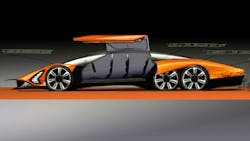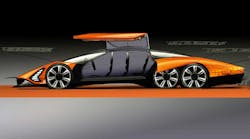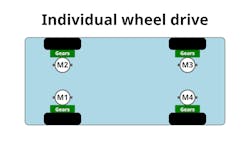Navigating the Challenges of Multi-Motor EVs
What you'll learn:
- Key Issues in Multi-Motor System Design
- Potential Benefits of a Four-Motor EV
- Issues Involved with Torque Vectoring Control
- How Does Torque Vectoring Control Work?
- Current Examples of Multi-Motor EV Applications with Torque Vectoring
- Challenges of Building a Multi-Motor EV Control System
- Challenges in Designing Multi-Motor EV Control Circuits
As with internal-combustion vehicles, the advantages of all-wheel drive for electric vehicles have been obvious from the start as has been the potential to provide multiple motors, ideally one for each driven wheel. Such vehicles have become more common, but they continue to present designers with challenges.
- The primary electrical challenges of controlling a four-motor EV include:
- Complex torque vectoring algorithms to manage individual wheel torque
- Increased wiring complexity
- Potentially higher power demands on the battery and control system under some conditions
- The need for precise synchronization of motor controls
That last challenge is due to the potential for uneven load distribution across motors or even motors, in effect, working against each other if not carefully instrumented and controlled. Finally, there’s the need for advanced fault detection and mitigation strategies due to the increased number of motor-control circuits and potential failure points.
>>Download the PDF of this article
What are the Key Issues in Multi-Motor System Design?
- Torque vectoring complexity: Accurately distributing torque to each wheel independently requires sophisticated algorithms to optimize traction and handling, especially in low-traction conditions, which can be computationally intensive.
- Wiring complexity: Managing the increased number of wires from four or more motors to the control unit adds to the overall system complexity, cost, and potential for failure points.
- Power demands: Operating multiple motors simultaneously places higher demands on the battery and power electronics, requiring careful design to manage current draw and heat dissipation.
- Synchronization issues: Ensuring all four motors operate in optimized synchronization to avoid jerky movements and maintain smooth driving experience is critical to user experience and safety. It becomes challenging when faced with the potentially wide variation in road surface and driving demands.
- Uneven load distribution: Uneven road conditions or driving dynamics can cause uneven load distribution across the motors, potentially impacting efficiency and performance.
- Fault detection and mitigation: With more motor-control circuits, implementing robust fault detection and mitigation systems or even fault-anticipating is crucial to ensure safety and prevent system failures.
What are the Potential Benefits of a Four-Motor EV?
Several obvious benefits to this design explains why many manufacturers are moving in this direction:
- Enhanced handling: Precise torque vectoring enables superior cornering stability and agility.
- Improved traction: Individual wheel torque control can optimize traction in challenging road conditions.
- Increased performance: Potential for higher acceleration and improved dynamic control.
What are the Issues Involved with Torque Vectoring Control?
Torque vectoring control is where many challenges converge, not the least being maintaining EV efficiency.
In a multi-motor electric vehicle (EV), "torque vectoring" refers to the ability to independently control the torque delivered to each wheel by utilizing multiple motors, allowing for precise adjustments to handling and stability by varying the power distribution between wheels, particularly during cornering, significantly improving steering response and cornering agility.
The core concept relies on having multiple electric motors, often with one motor per axle or even one motor per wheel, enabling independent torque control at each wheel. By adjusting torque distribution between wheels, the vehicle can actively counteract understeer or oversteer tendencies, leading to better cornering stability and responsiveness.
Software control is central to torque vectoring. The torque distribution is managed by sophisticated vehicle control software. It executes on real-time capable hardware, which analyzes inputs like steering angle, vehicle speed, and road conditions to determine the optimal torque distribution for each wheel.
How Does Torque Vectoring Control Work?
Two primary features characterize torque vectoring control: inside-wheel braking by reducing torque or regenerative/friction braking, and yaw moment control.
With inside-corner-wheel braking, during a turn, the inside wheel might be slightly slowed down by reducing its torque, while the outside wheel receives more torque to maintain grip. Though traditional automotive differentials accomplish an “averaging” of torque delivery through purely mechanical means, similar or better delivery of appropriate torque in multi-motor EVs may be accomplished through sensors and control circuitry.
Similarly, by adjusting the torque on individual wheels, the vehicle can generate a "yaw moment" to actively control the vehicle's rotation around its vertical axis. Yaw moment control is considered as a way of controlling the lateral motion of a vehicle during a severe driving maneuver. This is closely related to mature, and widely mandated, electronic stability control (ESC) technology, but the control challenges and potential advantages with individual wheel motors are even greater.
What are Some Current Examples of Multi-Motor EV Applications with Torque Vectoring?
This technology largely emerged from high-performance electric race cars, which often feature four independent motors, one per wheel, to maximize cornering performance. Production vehicles such as the Tesla Model X Plaid utilize a tri-motor system, the Rimac Nevera hypercar uses an inboard motor per wheel, and there’s one motor per wheel in the six-wheel Hennessey Hyper-GT (see image at top of article and Hennessey’s video below), with independent control of each motor for advanced torque vectoring.
What are the Challenges of Building a Multi-Motor EV Control System?
A "multi-motor EV control circuit" manages and controls the operation of multiple electric motors to deliver precise torque distribution and enhanced traction control. Key aspects of a multi-motor EV control circuit include the motor type, which is typically a brushless DC (BLDC) or permanent-magnet synchronous motor (PMSM) due to their high efficiency and precise control capabilities.
The central control unit (MCU) needs to be a powerful microcontroller that can process inputs from various sensors (like vehicle speed, wheel speed, steering angle) and calculate the necessary motor commands for optimal performance. Field-oriented-control (FOC) algorithms implement precise regulation of the motor's magnetic field to achieve exact torque control and smooth operation. As discussed, torque vectoring distributes torque independently based on road conditions and driver inputs, enhancing handling and stability.
Finally, appropriate communication protocols are needed to ensure effective and timely data exchange between the central control unit and individual motor controllers, coordinating motor actions across the vehicle.
What are Some Challenges in Designing Multi-Motor EV Control Circuits?
Accurate real-time calculations are needed to optimize torque distribution and ensure smooth transitions between different driving conditions. Then, maintaining precise motor synchronization is crucial to avoid vibrations and uneven power delivery. And, of course, this application of energy means that engineering ways to manage heat generation within the motor controllers can’t be neglected.
Another wrinkle in the deployment of individual wheel motors is where companies like Hyundai and Kia are currently developing "in-wheel" EV technology, with their "Uni Wheel" design that features a motor integrated directly into each wheel. Other companies are also reportedly exploring similar in-wheel motor technology for EVs (see figure).
In-wheel technology has all of the challenges involved with multiple motors, as well as potential issues with shock absorption, because the motor is directly exposed to road imperfections. Similarly, such designs would likely increase “unsprung weight,” which creates undesirable physics in terms of comfort and handling.
While companies actively research and develop in-wheel motor technology, and the related mechanical features of Uni Wheel, it’s not yet widely available in commercially produced EVs.
References
A Multi-Motor Architecture for Electric Vehicles
Intelligent Torque Vectoring Approach for Electric Vehicles with Per-Wheel Motors
To keep up with Electronic Design’s latest automotive-related articles, please subscribe to our Automotive Electronics bi-weekly newsletter.
>>Download the PDF of this article
About the Author



